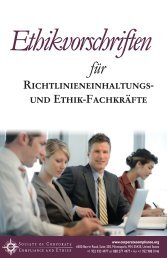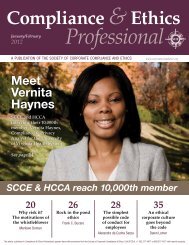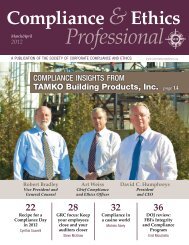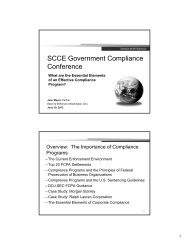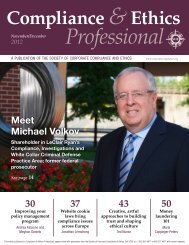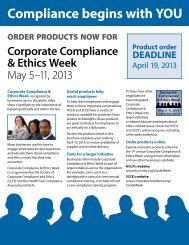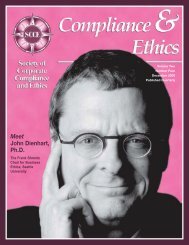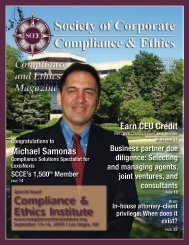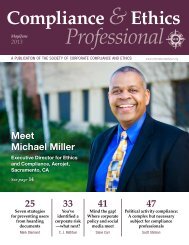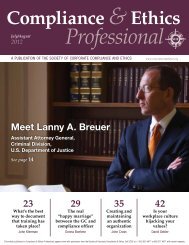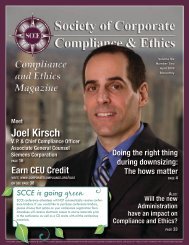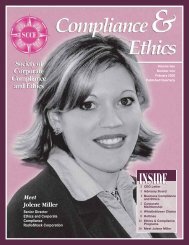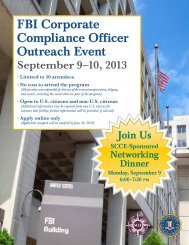Compliance &Ethics - Society of Corporate Compliance and Ethics
Compliance &Ethics - Society of Corporate Compliance and Ethics
Compliance &Ethics - Society of Corporate Compliance and Ethics
- No tags were found...
You also want an ePaper? Increase the reach of your titles
YUMPU automatically turns print PDFs into web optimized ePapers that Google loves.
m<strong>and</strong>ated that broker-dealers <strong>and</strong> investmentadvisers had to establish, maintain, <strong>and</strong>enforce reasonably designed written policies<strong>and</strong> procedures, taking into considerationdetails <strong>of</strong> their operations in order to preventthe misuse <strong>of</strong> material, nonpublic information.It is telling that, despite these guidelines,prosecutions for insider trading <strong>of</strong>ten relynot on the core law but on auxiliary violationssuch as perjury. The reason is that mensrea, or criminal intent, is <strong>of</strong>ten particularlydifficult to establish, because the accusedcan <strong>of</strong>ten claim that he/she always intendedto engage in the transaction <strong>and</strong> that it wascoincidental that the move was made prior tointernal awareness <strong>of</strong>, as yet, nonpublic informationabout an anticipated large gain or lossin the stock.What do the codes say?<strong>Corporate</strong> codes <strong>of</strong> conduct have became morewidespread <strong>and</strong> somewhat more complexwith the passage <strong>of</strong> time <strong>and</strong> with the federalm<strong>and</strong>ates discussed below, but their essentialnature does not differ much today from thecodes put in place during the half century thatfollowed the end <strong>of</strong> the second World War.The pioneer survey <strong>of</strong> corporate codes <strong>of</strong> conductwas undertaken in 1984 by Fried Frank,an international corporate law firm headquarteredin New York <strong>and</strong> with <strong>of</strong>fices in,among other places, London, Hong Kong, <strong>and</strong>Shanghai. The survey was updated three yearslater with about one-third <strong>of</strong> the companiesresponding. Subjects were companies listed byFortune magazine as the largest five hundredin the United States. Presumably, those whoresponded were the most likely to have codesin place (90% <strong>of</strong> them did), although organizationalprivacy <strong>and</strong> secrecy concerns may havelimited the response somewhat.A common thread in the codes was thedesire to protect the company from liability.Table 1, from the second Fried Frank survey,indicates the categories reported by thecompanies.TABLE 1: Issues addressed in corporate codes <strong>of</strong> conduct 13ISSUEPERCENTConflict <strong>of</strong> interest.......................................97%Gifts..............................................................87%Misuse <strong>of</strong> confidential information............. 83%Foreign corrupt practices .......................... 83%Political contributions ................................ 79%Insider trading .............................................73%Antitrust.......................................................64%Labor relations............................................ 27%Other........................................................... 29%Source: Siegel (2006:1603)Cressey <strong>and</strong> Moore also found what theycalled “a disproportionate degree <strong>of</strong> attention”accorded to conflicts <strong>of</strong> interest in the corporatecodes. They note that this discrepancy isparticularly pronounced in regard to nonindustrialfirms. They believe that a traditionalemphasis had been placed on preventing actsdirectly harming the company <strong>and</strong> that onlyrecently had concerns about public interestscome to the fore. 14The Federal Sentencing GuidelinesThe compliance code movement picked upconsiderable speed in 1991 with the introduction<strong>of</strong> the United States SentencingCommission’s Guidelines for the Sentencing<strong>of</strong> Organizations (FSGO), 15 a document thatset out criteria for aggravating or mitigatingstipulated penalties. The FSGO established“the most significant impetus toward internalcorporate policing.” 16 The most important mitigatingfactor was the presence <strong>of</strong> a program“to prevent <strong>and</strong> detect violations <strong>of</strong> law.” TheCommission issued what came to be calledthe “seven steps” for constructing a satisfactorycompliance effort. These steps call for aprogram that is “reasonably designed, implemented,<strong>and</strong> enforced so that it generally will<strong>Compliance</strong> & <strong>Ethics</strong> Pr<strong>of</strong>essional May/June 2012+1 952 933 4977 or 888 277 4977 | www.corporatecompliance.org 57



